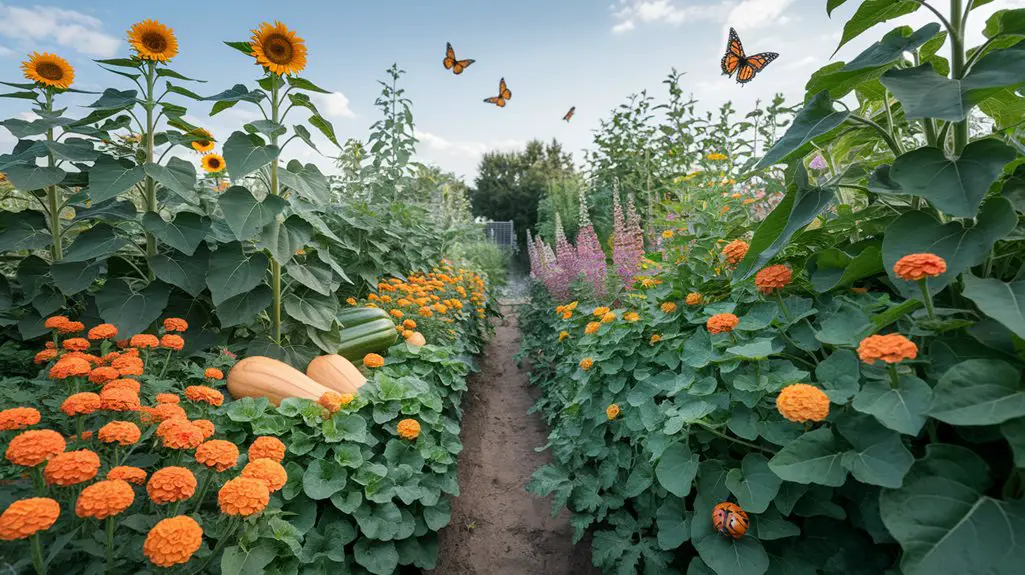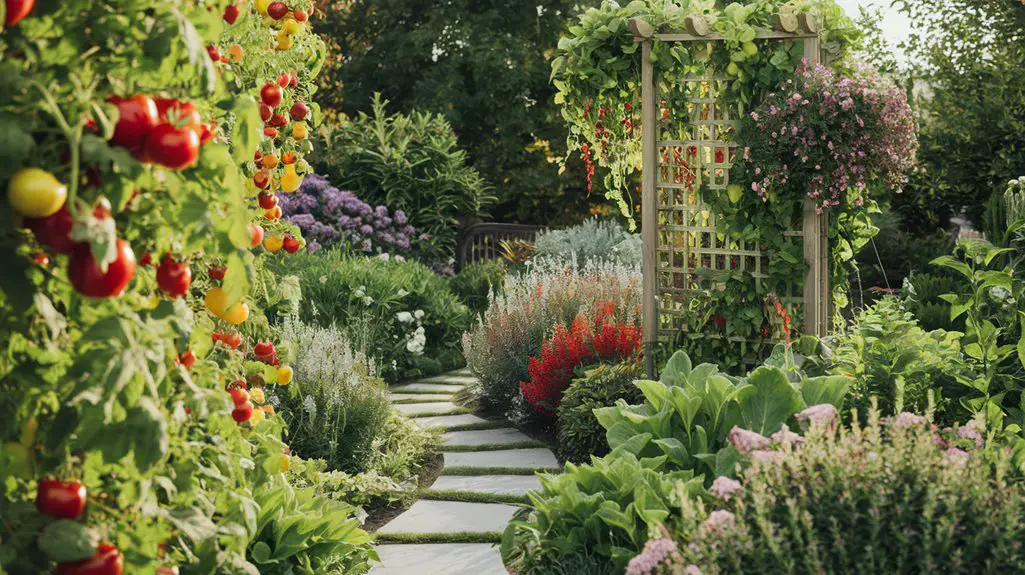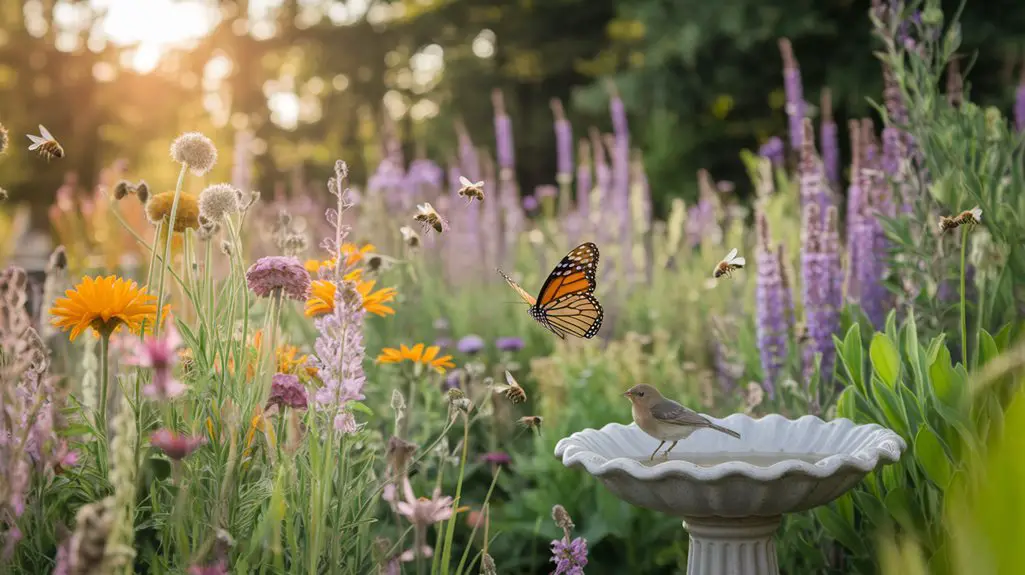You've probably noticed that certain plants seem to thrive together while others struggle when paired. This isn't coincidental—it's companion planting at work. When you position compatible species near each other, you're creating synergistic relationships that can boost growth, deter pests, and enhance flavors. The strategic placement of plants mirrors nature's own ecological balance, where diverse communities support each other's needs. But which combinations will transform your garden from surviving to flourishing?
The Science Behind Companion Planting
The ecological foundation of companion planting lies in biomimicry—the practice of emulating nature's successful strategies.
In natural ecosystems, diverse plant communities thrive through complex biochemical interactions rather than monocultural isolation. These relationships operate through several key mechanisms you can leverage in your garden.
Plants communicate via allelopathy—releasing compounds that inhibit or enhance neighboring growth. You'll find this exemplified when marigolds release thiopene to repel nematodes, protecting vulnerable vegetables nearby.
Other plants attract beneficial insects through volatile organic compounds, creating natural pest management systems.
Root depth diversification allows companion plants to access different soil nutrients without competition. When you pair shallow-rooted lettuce with deep-rooted carrots, you're maximizing soil resource utilization.
Incorporating composting techniques into your garden can further enhance the health and productivity of companion plants.
These scientifically validated principles transform companion planting from folk wisdom into strategic horticultural practice.
Top Companion Plant Pairings for Vegetable Gardens
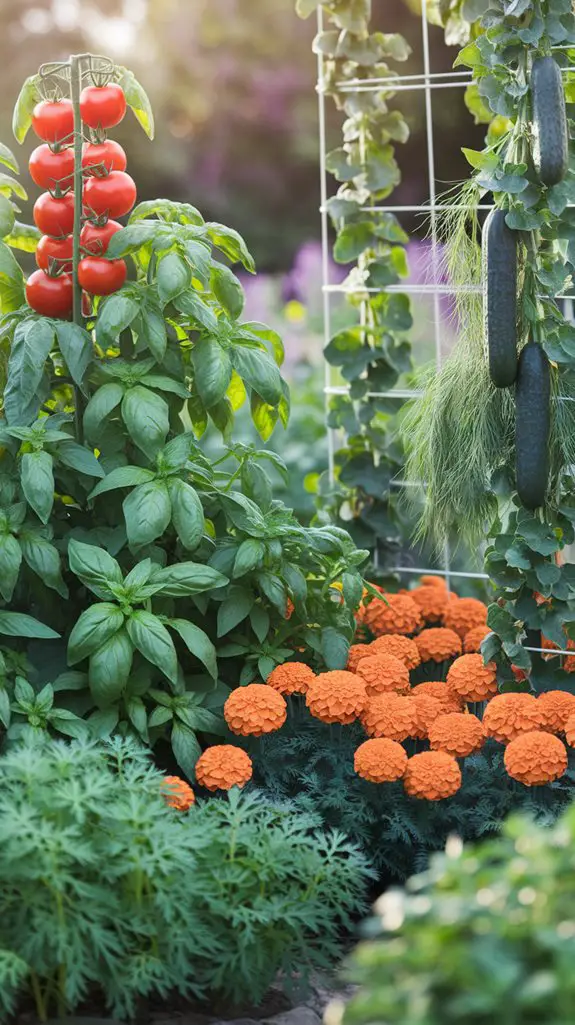
Successful vegetable gardens rely on these ten essential companion pairings that maximize yield while minimizing pest pressure.
These strategic combinations leverage biochemical interactions and spatial efficiency to create resilient growing systems.
- Tomatoes + Basil: Basil repels tomato hornworms while improving flavor; plant 12" apart
- Carrots + Onions: Onion family masks carrot scent from carrot flies; interplant in alternating rows
- Cucumbers + Nasturtiums: Nasturtiums act as trap crops for aphids while attracting pollinators
- Brassicas + Aromatic herbs: Rosemary and thyme deter cabbage moths with volatile oils
- Beans + Corn: Beans fix nitrogen while corn provides structural support; add squash for traditional "Three Sisters" planting
Implement these combinations in your garden beds to establish beneficial relationships that enhance growth without synthetic inputs.
Herbs as Beneficial Companions for Flowers and Vegetables
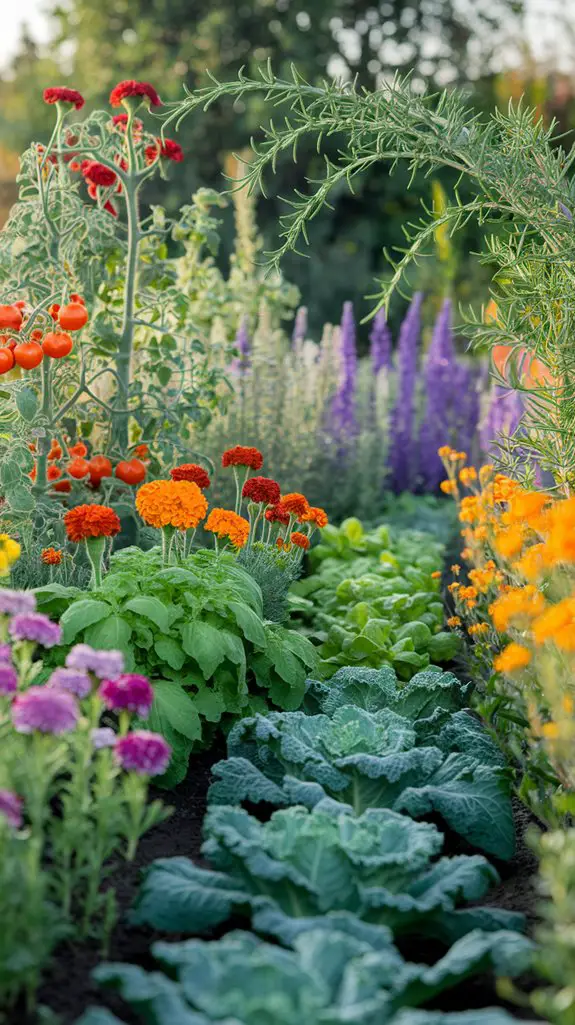
Versatile beyond culinary uses, herbs serve as powerful allies in mixed plantings due to their aromatic compounds and structural diversity.
Their essential oils repel destructive insects while attracting beneficial pollinators critical for fruit set and seed production.
Basil enhances tomato flavor and deters thrips and flies, while rosemary's potent oils protect cabbage family plants from cabbage moths.
Plant chives near roses to prevent black spot and aphid infestations. Mint deters cabbage moths, ants, and rodents, but always contain it in pots to prevent invasive spreading.
You'll find thyme excellent for suppressing soil-borne pathogens when planted between brassicas.
Borage strengthens disease resistance in neighboring strawberries and tomatoes while attracting pollinators with its vivid blue flowers. Additionally, using natural pest control methods can further enhance the health of your garden by minimizing harmful pest populations without chemicals.
Natural Pest Control Through Strategic Plant Combinations
Strategic plant pairings provide five powerful approaches to natural pest control without synthetic chemicals.
By thoughtfully arranging your garden's layout, you'll create a resilient ecosystem that naturally deters destructive insects while attracting beneficial predators.
- Plant aromatic deterrents like marigolds near tomatoes to repel nematodes through root exudations.
- Establish trap crops such as nasturtiums to divert aphids away from your primary vegetable crops.
- Incorporate confusing polycultures that disrupt pest recognition patterns through diverse scents.
- Cultivate insectary plants like dill and fennel to attract predatory wasps and ladybugs.
- Deploy physical barriers with tall, dense plants like sunflowers that block pest migration routes.
These combinations work through multiple mechanisms—biochemical interference, habitat manipulation, and predator-prey dynamics—creating a balanced garden where pests remain below damage thresholds. Additionally, a thriving herb garden can significantly enhance your garden's appeal to beneficial insects.
Spacing and Layout Strategies for Companion Planting
Effective companion planting depends on three critical spacing considerations that optimize plant interactions while preventing resource competition.
First, respect mature plant sizes by allocating appropriate square footage for each species' full development. You'll need to contemplate both above-ground spread and below-ground root zones.
Second, arrange companions based on height gradients—tall plants should occupy northern positions to prevent shading shorter allies. This vertical stratification maximizes sunlight exposure while creating beneficial microclimates.
Finally, implement appropriate density patterns. Interplant shallow-rooted species between deep-rooted neighbors to utilize different soil layers. Maintain adequate airflow by avoiding overcrowding, which can lead to disease proliferation.
For row-based layouts, alternate compatible species every 2-3 rows; for intensive methods, distribute companions in calculated clusters or polyculture blocks that mirror natural ecosystems.
Seasonal Planning for Year-Round Companion Benefits
Companion planting's benefits extend throughout the growing calendar when you implement thoughtful seasonal planning.
By rotating plant partnerships across seasons, you'll maintain soil health while disrupting pest cycles.
- Sequence early spring cool-weather companions (peas/radishes) before summer heat-lovers (tomatoes/basil)
- Plant fall cover crops like clover or vetch after summer harvests to fix nitrogen for spring plantings
- Interplant quick-maturing crops between slower-growing perennial companions
- Maintain year-round beneficial insect habitat with sequential blooming companion flowers
- Develop succession planting schedules that account for allelopathic effects between crop rotations
Additionally, utilizing companion planting techniques can enhance biodiversity and resilience in your garden ecosystem.
Don't limit companion strategies to a single season.
Map your garden plan annually, documenting successful pairings and failures to refine your approach for continuous improvement across multiple growing cycles.
Conclusion
You'll reap what you sow when implementing these companion planting techniques in your garden. By strategically positioning compatible plants, you're establishing natural defense mechanisms and optimizing growth potential. Don't overlook seasonal changes—adapt your companion configurations accordingly. Maintain proper spacing between plant groupings to maximize beneficial interactions while minimizing competition. Track your results systematically, adjusting combinations based on observed outcomes for continuous garden ecosystem improvement.

